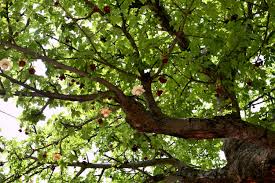Heavenly Trees and Celestial Dogs

Day two with Prashant Iyengar brought us to understanding the journey “from dogma to pragmatism”, from just points and actions to study and exploration. Yesterday he urged us to look at asana as not just posture, but an integration of breath and mind to embrace an educative process instead of just a physical one. Today he went a step further to mention that truly we are never “posture-less”. Any way we carry ourselves through this world is within a “posture”, so how do we add awareness and sensitivity to our activity in order to make asana a tool for yoga? Can we “flush out” mundanity and move toward transforming ourselves for this more spiritual endeavor of freedom and absorption?
To begin this journey we must first know our “starter position”, be sensitive to our current needs and have knowledge and awareness around what to do for that time and need. How you are feeling emotionally and energetically have just as much weight as how you are feeling physically for your “given conditions” for yoga. Making a “clinical diagnosis” about your “starter position” should lead you on the path of transformation into a better condition to continue practice. If the asana you chose to help your given condition does not make you feel better, then you may choose something different, or if the asana you chose has a more positive energetic or emotional outcome, you may choose to continue toward a different scheme.
To practice this point, Prashant gave us a few options to start with since it was still a class situation. However, he reminded us that in a regular class situation there are not as many options given, so sooner or later we have to become “personally dependent” in practice, to not just move with will power, but with intelligence. I was menstruating this morning, so I chose a more restful approach to my first Downward Dog, supported on ropes and with my head supported. In staying for a time, we were encouraged to not just do or stay for timing, but to maintain, to build connectivity, relativity, and efficacy. Since my first approach to Adho Mukha Svanasana released some of the heaviness and stiffness I was feeling, I felt I could continue toward standings. However, if through “diagnosis” I had felt not renewed or still sluggish, I might have continued with a more supine practice.
With intelligence in asana and this “pragmatic approach”, the content of thought and mind improves along with the container. The definition of yoga is “yoga citta vrtti nirodha” – quieting the fluctuations of the consciousness – so asana HAS to become a “thought matter process”. And this process reveals that in the end yoga will bring you all that you wish and strive for. If you wish for body health, it will come with that intelligence. If you wish to heal emotional strains, with intelligence that will come. And if you wish for full enlightenment , with intelligence that too will come.
Prashant likened yoga to the Kalpavrksa – the heavenly tree that brings whatever fruit or result you ask of it when you sit beneath it.
But he warned not to be fooled by the idea of “putting your whole mind into this endeavor”. If you do not follow the definition of yoga to remove fluctuations and disturbances within the consciousness, then “putting your whole mind into it” brings all the obstacles and unhelpful mind-stuff along with it. We have to recognize and be pragmatic and discerning about bringing our “right mind” to our approaches and practices of yoga. We have to develop an “internal social society” where we act with manners and decency and create a comfortable “seat for the consciousness to settle into” – the definition of asana.
He finished this asana exploration by looking at the transformation of the “boorish dog pose” into the “celestial dog” of Adho Mukha Svanasana in yoga. There is every type of dog for every purpose using certain breeding or training. So in yoga, we breed and train our basic physical “dog pose” to become Adho Mukha Svanasana – the perfect seat for our consciousness. Every approach to Adho Mukha Savanasana gives us knowledge and access to “covert” aspects of our Self. We just have to be willing to look deeper than the “overt” straight legs and arms and trunk, to utilize every avenue given to become completely absorbed and experience ultimate celestial freedom.
We did Savasana in supported Setu Bandha Sarvangasana (bridge pose). Here, after exploring asana with more controlled breathing, we were reminded that even that work is not an “accomplishment” in yoga. Breath techniques bring us information and intelligence, but in the end, “Samadhi (enlightenment) must be found with your normal breath”.
So much to chew on until next week…